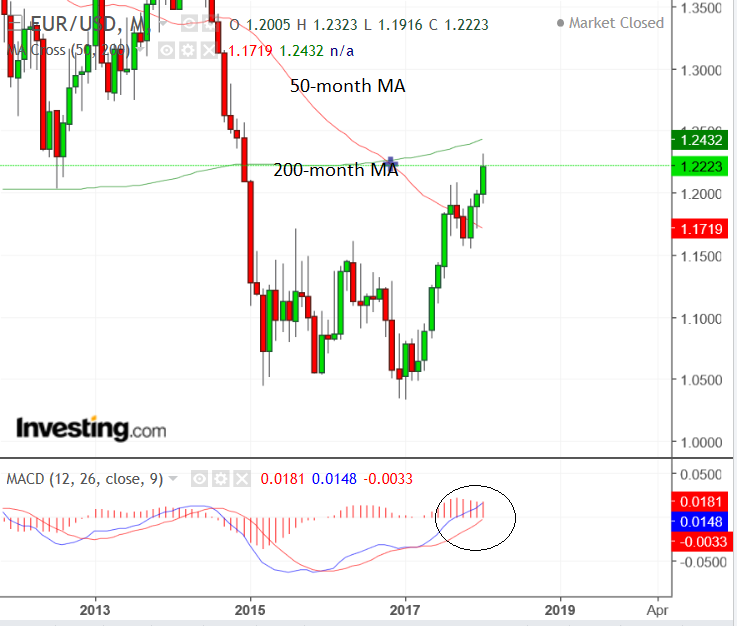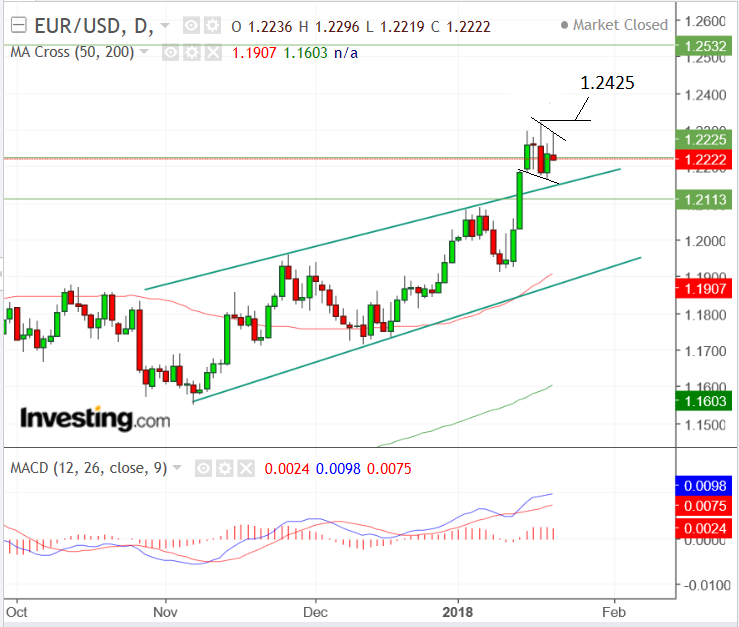Euro-to-Dollar Rate Forecast for the Week Ahead

A pause in the EUR/USD uptrend may extend in the coming week as neither currency presents an attractive buy option due to substantial overhanging risks.
Whilst downside pressure on the Dollar is likely to mount after the US government had to shut down from lack of funds, Euro bulls may not be in a position to take advantage due to the event risk presented by the European Central Bank (ECB) rate meeting on Thursday.
There is a possibility the pair may simply go sideways as neither currency outperforms the other.
Yet, from a technical perspective, the pair is still in an uptrend despite spending the last week consolidating within a narrow range between the 1.2325 highs and the 1.2175 lows.
Although it looks overbought overall, the up-trend is still technically intact given the lack of downside momentum: note, for example, the MACD indicator which is still rising bullishly and thus corroborating a continuation of the uptrend.
We think the current pull-back probably just represents a pause in the uptrend, and any further weakness will be supported by the top of the rising channel at about 1.2170.
A break above the range highs (1.2325) would confirm a continuation of the uptrend to the next target at 1.2425 which is composed of the 200-month moving average.
We see a strong chance of prices stalling here as they did at the end of 2017 when they touched the 50-month MA at 1.1720 as shown on the monthly timeframe chart below:

Advertisement
Get up to 5% more foreign exchange by using a specialist provider to get closer to the real market rate and avoid the gaping spreads charged by your bank when providing currency. Learn more here.
Data and Events for the Euro
The main event for the Euro in the week ahead is the ECB policy meeting at 12.45 on Thursday, in Frankfurt.
No change in policy is expected at the meeting but the market is alert to possible changes in the bank's 'forward guidance' or in layman's terms its message on how it expects its policies to evolve in the future.
This is due to certain passages in the previous meeting minutes which suggest a significant proportion of the ECB governing council think forward guidance needs to be updated near the beginning of 2018, although most analysts think this means the March meeting, not January - and this has been backed up by unnamed sources at the ECB.
Yet given the ECB's market preference for making changes very gradually, there may be a few tweaks in the language of the
January statement too and these could move the Euro, especially if they indicate optimism in the economic outlook, as this will suggest a speedier end to the ECB's emergency QE programme, which is overall a negative influence on the Euro.
The other major focus for the market will be whether the ECB's statement or Mario Draghi in the live press conference afterward mention the strength of the Euro, which has risen by 13% (versus USD) in under a year.
An overly strong Euro will dampen inflation by lower the price of imports and therefore essentially act contrary to the goals of the ECB which is to raise inflation back up to its just-below 2.0% target.
Three members of the governing council have already expressed concerns about the strength of the Euro in the last week and investors are now speculating as to whether the ECB will try to use verbal intervention to talk it down on Thursday.
One issue is that not all the governing council feel the same way about the Euro being over-strong.
France, for example, is at one pole in that it would prefer a weaker Euro because of its own French problems but Germany is that the other and see's no problems in the Euro's current exchange rate - thus the rising Euro has the potential to spark a rift with the ECB, and perhaps because of this Draghi will be mindful not to take sides and try to avoid direct answers on the subject.
Finally, it is also worth remembering that the Euro is much stronger against the US Dollar than versus a combine basket of counterparts against which it has risen much more modestly, and is only 2.0% above the assumptions made in the ECB's staff macro-economic projections published at the December meeting, whereas EUR/USD in comparison is substantially higher now than the assumption of 1.17 in the projections.
The Euro's strength is therefore not broad-based.
Other key data from Europe in the week ahead include Manufacturing and Services PMI data for January out at 9.00 GMT on Wednesday.
This is survey data from interviews with Purchasing Managers in the industry sectors covered and provides a normally very accurate picture of activity levels.
Manufacturing reached a survey history high of 60.6 in December and is forecast to moderate to 60.3 in Jan; Services is expected to slide to 56.4 from 56.6.
The ZEW Investor Sentiment survey on Tuesday completes the major releases for the Euro in the week ahead.
Economic Sentiment in Europe is forecast to rise to 30.0 from 29.0 in January by ZEW.
Data and Events for the Dollar
The main event to affect the Dollar in the coming week is the news of the US government shutdown late on Friday after the Senate failed to pass an extension of the government's borrowing limit.
The US government has run out of money and so all non-essential services will now have to be shut down.
From the perspective of the Dollar, it will be a negative event judging from previous shut-downs.
"The last time the U.S. government was officially shut down was in October 2013 for 16 days. The dollar declined as it has now the month leading up to the shutdown. Then halfway through, it bottomed out as investors moved on," says BK Asset Managment Managing Director Kathy Lien.
"When Congress passed the Continuing Appropriations Act of 2014 that suspended the debt limit until February, the dollar index actually extended its losses before bottoming a week later," she continues.
She underscores the fact that the shutdown did not seem to impact negatively on growth in the past, however, and so it is not expected to be negative for the Dollar long-term.
As far as hard data goes, the next big release for the Dollar is fourth quarter GDP on Friday at 13.30 GMT, which is forecast to moderate to 3.0% compared to the same quarter in 2016, from 3.2% previously.
Get up to 5% more foreign exchange by using a specialist provider to get closer to the real market rate and avoid the gaping spreads charged by your bank when providing currency. Learn more here.











